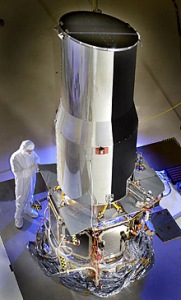Aug 27 2013
Ten years ago, NASA's Spitzer Space Telescope – built, integrated and tested at Lockheed Martin Space Systems in Sunnyvale – roared into space from the Kennedy Space Center in Florida, carrying the observatory into an Earth-trailing orbit around the sun.
 Spitzer Space Telescope (SIRTF) in Space Systems cleanroom
Spitzer Space Telescope (SIRTF) in Space Systems cleanroom
The Spitzer Space Telescope is a space-borne, cryogenically-cooled infrared observatory that studies objects ranging from our Solar System to the distant reaches of the Universe. Lockheed Martin Space Systems in Denver provides mission support for Spitzer spaceflight operations in conjunction with the Jet Propulsion Laboratory and the California Institute of Technology.
“We are extremely proud of our decades of work on behalf of NASA, and honored to have played such a key role in the Spitzer Space Telescope program,” said Jim Crocker, Lockheed Martin vice president of Civil Space. “It is particularly satisfying because celebrating Spitzer’s 10th anniversary seemed unlikely at the outset as the mission was designed to last between two and five years.”
In May 2009 the onboard liquid helium supply on Spitzer was exhausted. The mission was extended, however, because the two shortest wavelength detectors in Spitzer’s camera continued functioning perfectly as the observatory trailed far behind the Earth in its orbit, through the cold of deep space.
The Spitzer Space Telescope views the universe in infrared light, which is largely blocked by the Earth’s atmosphere. With Spitzer, astronomers have determined that Earth-like planets form around many, if not most of the nearby Sun-like stars in our galaxy, suggesting that the potential for life might be more common that previously thought. In looking at our own galaxy – the Milky Way galaxy – the observatory has given astronomers valuable insights by revealing where new stars are forming. In addition, the infrared eyes of Spitzer are ideal for studying distant planet forming disks, and characterizing planets beyond our Solar System.
The spaceborne Spitzer observatory comprises a 0.85-meter diameter telescope and three scientific instruments capable of performing imaging and spectroscopy in the 3-180 micron wavelength regime. Spitzer has provided more than a 100-fold increase in scientific capability over previous infrared missions. Ball Aerospace in Boulder, Colo. built Spitzer’s Cryogenic Telescope Assembly, which includes the scientific instruments.
Spitzer was the fourth and final member of NASA’s family of Great Observatories, which also includes the Chandra X-Ray Observatory, the Compton Gamma Ray Observatory, and the Hubble Space Telescope – also built, integrated and operated by Lockheed Martin. The interaction of multiple Great Observatories coordinating observations enabled a greater science return and deeper understanding as astronomical phenomena could be imaged simultaneously over many different wavelengths. Hubble, Spitzer and Chandra remain in operation.
Lockheed Martin Space Systems Company, a major operating unit of Lockheed Martin Corporation, designs, develops, tests, manufactures and operates a full spectrum of advanced technology systems for national security and military, civil government and commercial customers. Chief products include human space flight systems; a full range of remote sensing, navigation, meteorological and communications satellites and instruments; space observatories and interplanetary spacecraft; laser radar; ballistic missiles; missile defense systems; and nanotechnology research and development.
Headquartered in Bethesda, Md., Lockheed Martin is a global security and aerospace company that employs about 116,000 people worldwide and is principally engaged in the research, design, development, manufacture, integration, and sustainment of advanced technology systems, products, and services. The Corporation’s net sales for 2012 were $47.2 billion.